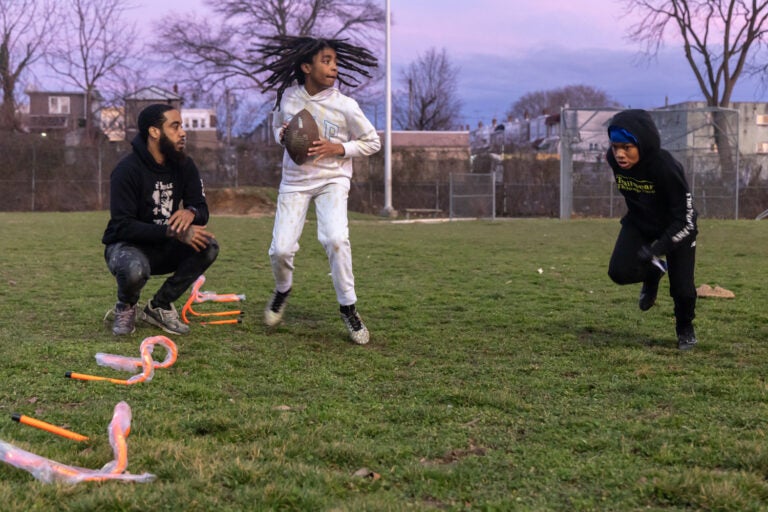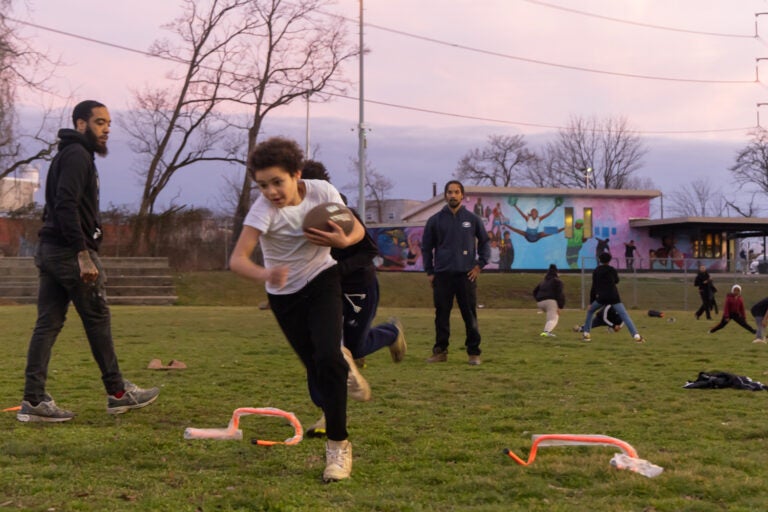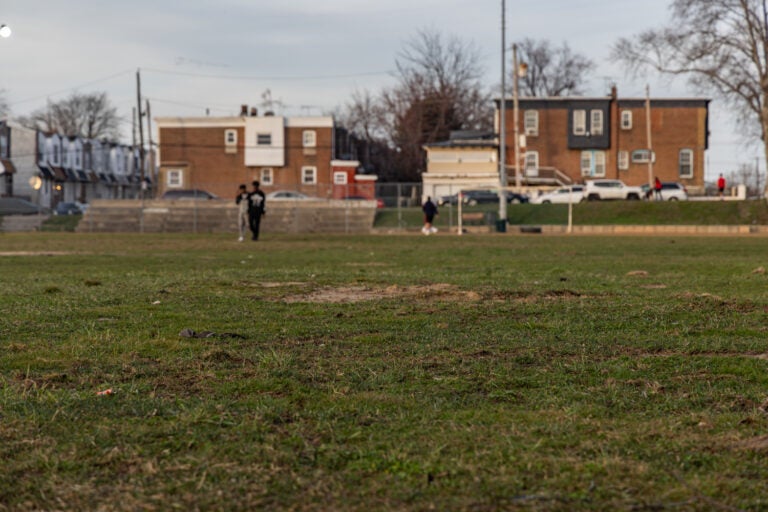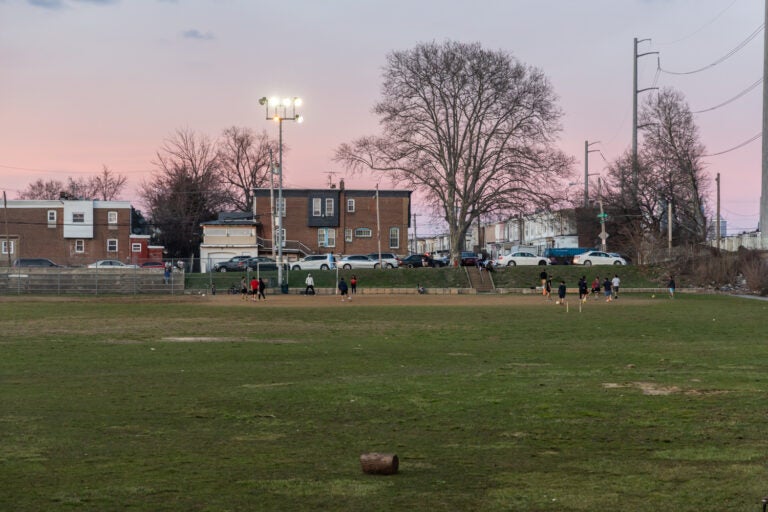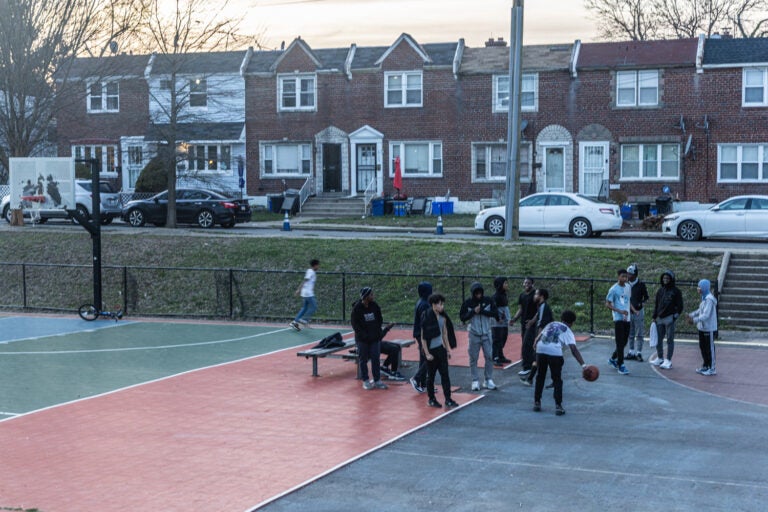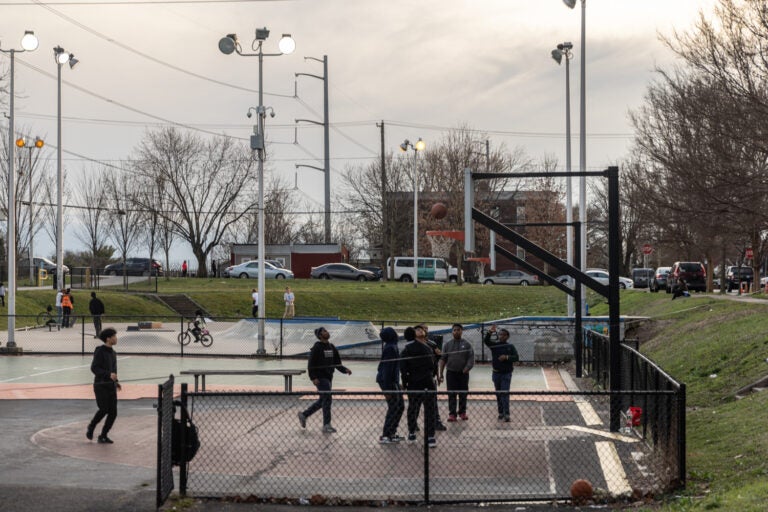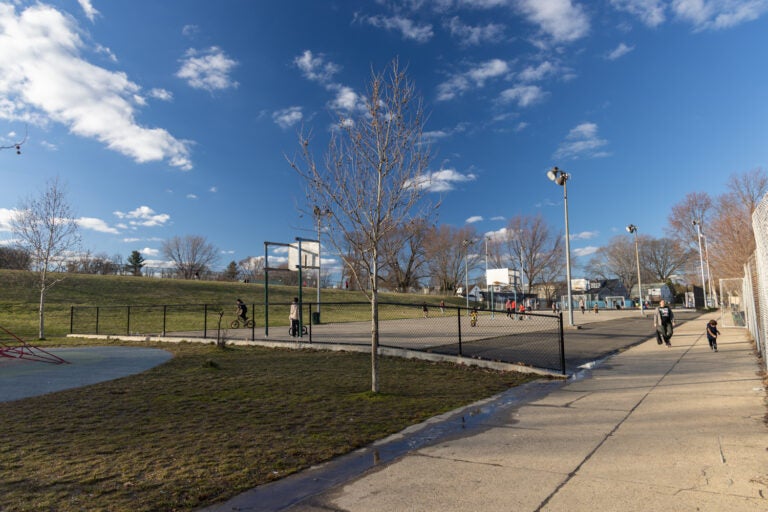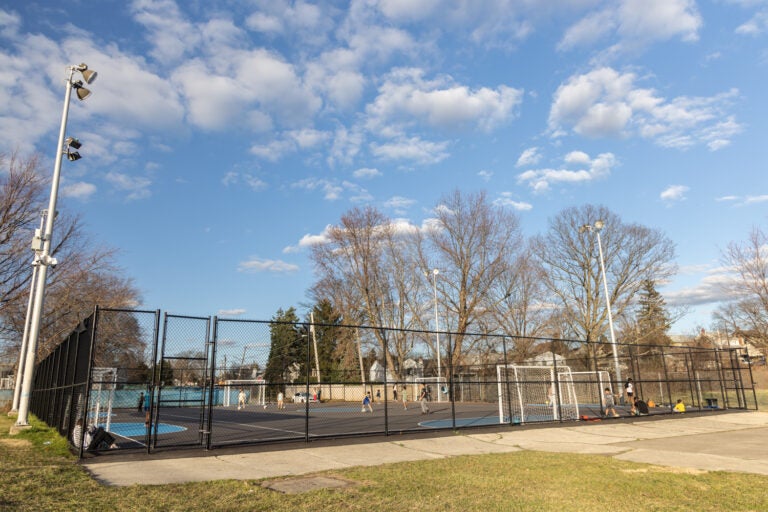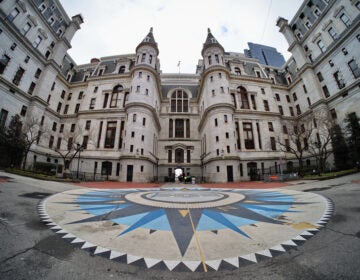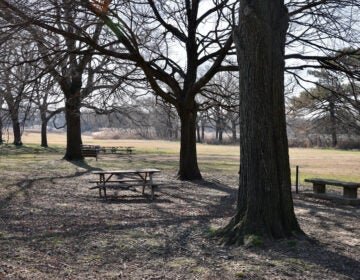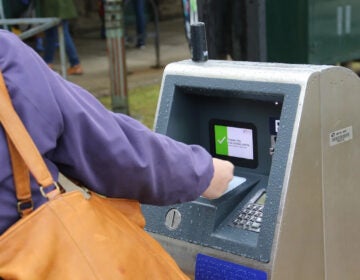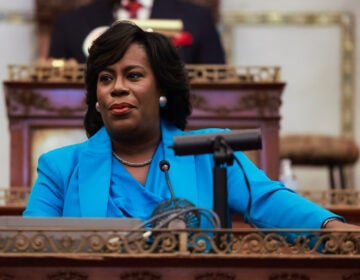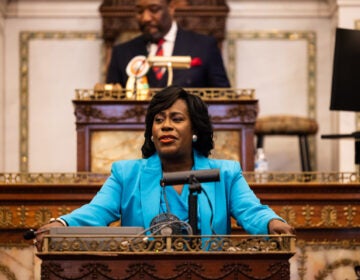‘Don’t forget about us’: Advocates hope Parker moves the needle on Parks & Rec improvements
After taking office, Parker promised to make Philly the “safest, cleanest, and greenest big city in the nation.” Advocates for parks and youth sports have high hopes.
Have a question about Philly’s neighborhoods or the systems that shape them? PlanPhilly reporters want to hear from you! Ask us a question or send us a story idea you think we should cover.
On a recent warm evening, McCreesh playground in Southwest Philadelphia buzzed with kids practicing tricks on the skate park ramps and shouting from the basketball courts.
As the sun set and the sky glowed pink, two volunteer coaches gathered a small group of elementary age boys for one of the CLS Mustangs’ first football practices of the season.
They played on McCreesh’s well-loved and well-worn field, which is little more than thin grass in places, with bare dirt and sand showing through. When it rains, water tends to pool on the field, sometimes forcing the team to postpone or relocate games, Mustangs president Cliff Logan said, and the uneven surface can be dangerous.
“Injuries — real bad injuries,” Logan said, remembering one child’s torn ACL and another’s pulled hamstring. “A lot of times they may stumble over the hill. Sometimes they don’t see the crater or the rocks in the field. So that’s definitely injuries, and not safe.”
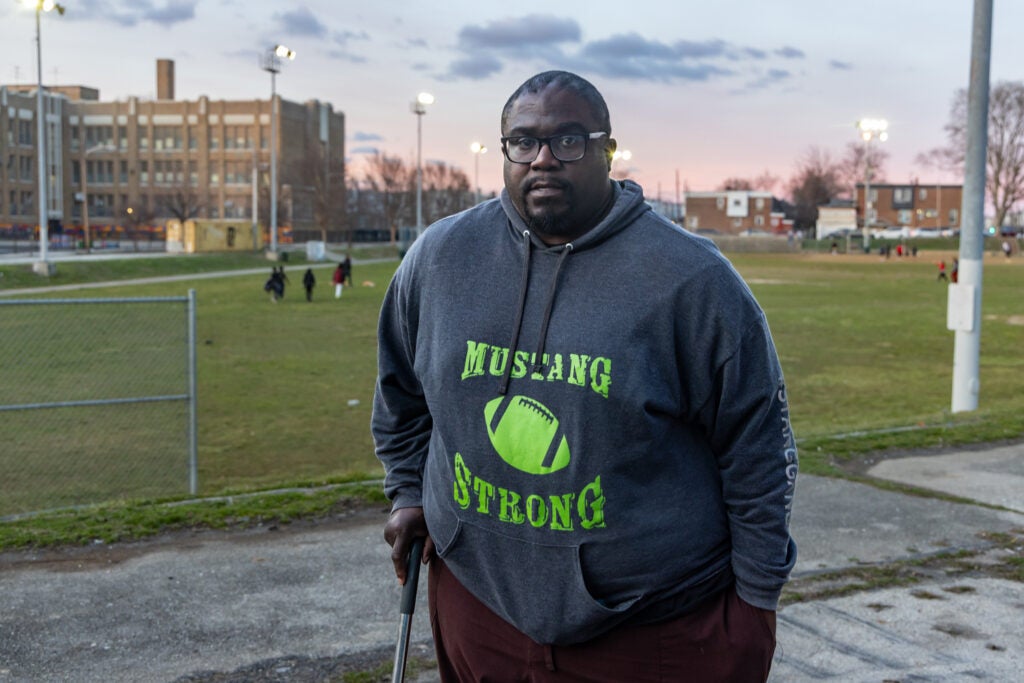
McCreesh is one of the city’s dozens of rec centers and parks, many of which advocates say need repairs and more robust attention to maintenance and staffing than the city has historically provided.
Although the Department of Parks & Recreation’s budget has grown in recent years, Philly still spends less per resident on parks than the average big U.S. city, and more of that investment comes from private organizations. It also depends on the manpower and resources of many volunteer and Friends groups.
As a candidate last year, Cherelle Parker said she’d like to “at least double” the city’s investment in Parks & Rec operations by the end of her first term. After taking office, she promised to make Philly the “safest, cleanest, and greenest big city in the nation.”
Advocates hope the mayor’s first budget proposal, expected Thursday, reflects those goals.
“This mayor cares, deeply so, about Parks and Recreation, about safer places and spaces for children, families and others to go to recreate and play, and our FY2025 budget will reflect that,” said Parker’s spokesperson Joe Grace. The department “is essential to the mayor’s overarching vision of a safer, cleaner, greener Philadelphia, with access to economic opportunity for all.”
The Park & Rec Heroes Fund, a coalition of groups formerly called the Philadelphia Parks Alliance, is asking for a $13.2 million increase in the department’s annual budget — $4.4 million more for maintenance and $8.8 million for recreation staffing, according to Fairmount Park Conservancy CEO Maura McCarthy.
“Despite our incredibly robust public engagement with our parks, sometimes there’s no replacement for good old tree care or repairing roads, stuff that the public can’t do,” McCarthy said.
That would represent a more than 16% increase over the department’s current $79.4 million budget. Advocates want to see Parker support sustained improvements to parks and rec centers, including consistent maintenance, more staff, renovations of sports fields and courts, accessible public bathrooms, and better security.
“I’m in favor of what she is doing thus far,” Logan said. “I just hope that she don’t forget about us here, like everyone else has.”
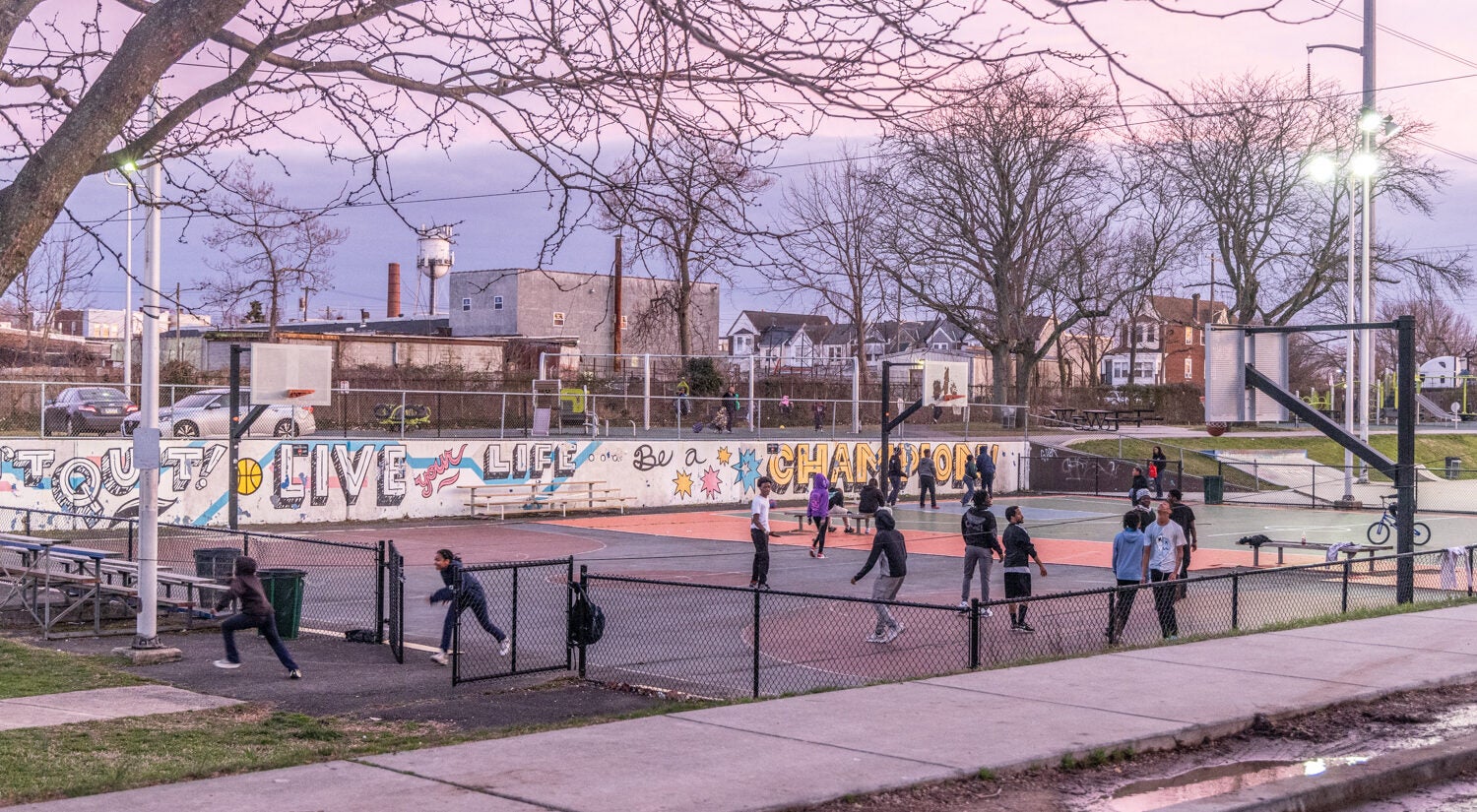
After new projects, a struggle to maintain them
Many park advocates and users argue that a heightened focus on maintenance is the key to keeping Philly’s network of parks and rec centers safe, welcoming and user-friendly.
“It’s not flashy. It doesn’t come with gorgeous renderings. But this is what’s needed to make our neighborhood resources safe and encourage use,” said Avigail Milder, a South Philly resident and frequent user of FDR park, where she likes to take nature walks and watch birds.
Among the 100 largest parks systems in the U.S., Philadelphia ranks 81st for the amount it spends on park maintenance per resident, said Owen Franklin, Pennsylvania state director for the nonprofit Trust for Public Land.
“Everybody falls in love with beginnings. That’s natural. We love to build new things,” said Franklin, whose organization helps fund park and playground projects. “But we struggle to find the right priority level for maintenance spending to care for these new investments day after day after day.”
Some cities and states have dedicated sources of funding for park operations, such as taxes on marijuana sales or sporting event tickets, he said. Philadelphia has a sweetened-beverage tax that funds Rebuild, but money for staff and maintenance is subject to negotiation every year.
The Trust for Public Land supports the idea of establishing a dedicated funding source for those expenses, he said.
The recent history of Vernon Park in Germantown illustrates the importance of regular upkeep and repairs, said Angela Miles, president of the park’s Friends group.
In 2015 the city renovated Vernon’s playground and added badly needed light posts. But two weeks after the work was finished, a truck backed into one of the new posts and knocked it down.
“The wires were exposed,” Miles recalled. “We were constantly putting contractor buckets and cones on top of it.”
The next year, a dead tree toppled in a storm, smashing a long section of fence. “Not having fencing there, on a really busy street, was very concerning,” Miles said. “These items were top priority for us.”
But repair requests went unaddressed for seven years, until last year Rebuild finally launched a project to put up a new light post, replace the missing fences, remove dead trees, and upgrade the baseball field and trash cans.
New, Rebuild-style activations of public space are “exciting,” Miles said, “but they’re not an excuse to turn away from the basic infrastructural maintenance that makes our parks look and feel healthy and cared for.”
In the absence of robust funding for park maintenance, volunteer Friends groups often fill the gaps. But this means parks throughout the city receive unequal levels of stewardship, said Kiasha Huling, an environmental advocate at the Clean Air Council and board chair of UC Green, a community greening organization in University City.
“There might be parks where folks are more civically connected and they create a friends-of group, and they organize cleanups. There may be parks where there’s someone who would do that, but they don’t know how to do that,” Huling said. “In the absence of that volunteer service, the service to those parks doesn’t happen at all.”
Huling wants to see Parks & Rec under the new administration better coordinate between volunteer groups and city maintenance services, to make sure parks with the least volunteer labor get the attention they need.
The volunteers themselves also need more support, said West Philly resident Ro Maurer. She frequents Morris Park and the Wissahickon, and volunteers with Cobbs Creek Ambassadors, a group that cleans up tons of trash from the West Philadelphia park. She’d like to see the city provide grants, equipment or a helping hand.
“There’s a lot of trash being dumped that’s just too heavy. Lots of tires, lots of really heavy equipment, shopping carts,” Maurer said. “The city could come through several times a month and just get some of the larger items out of rivers and creeks, or … the needles in the Wissahickon.”
Maurer also wants to see park bathrooms consistently kept clean and unlocked for visitors.
“We have parents with small children using the park. We have people who have various disabilities that need to have a working bathroom close by,” she said. “I’d like to see more effort put toward making the parks more accessible to the general public.”
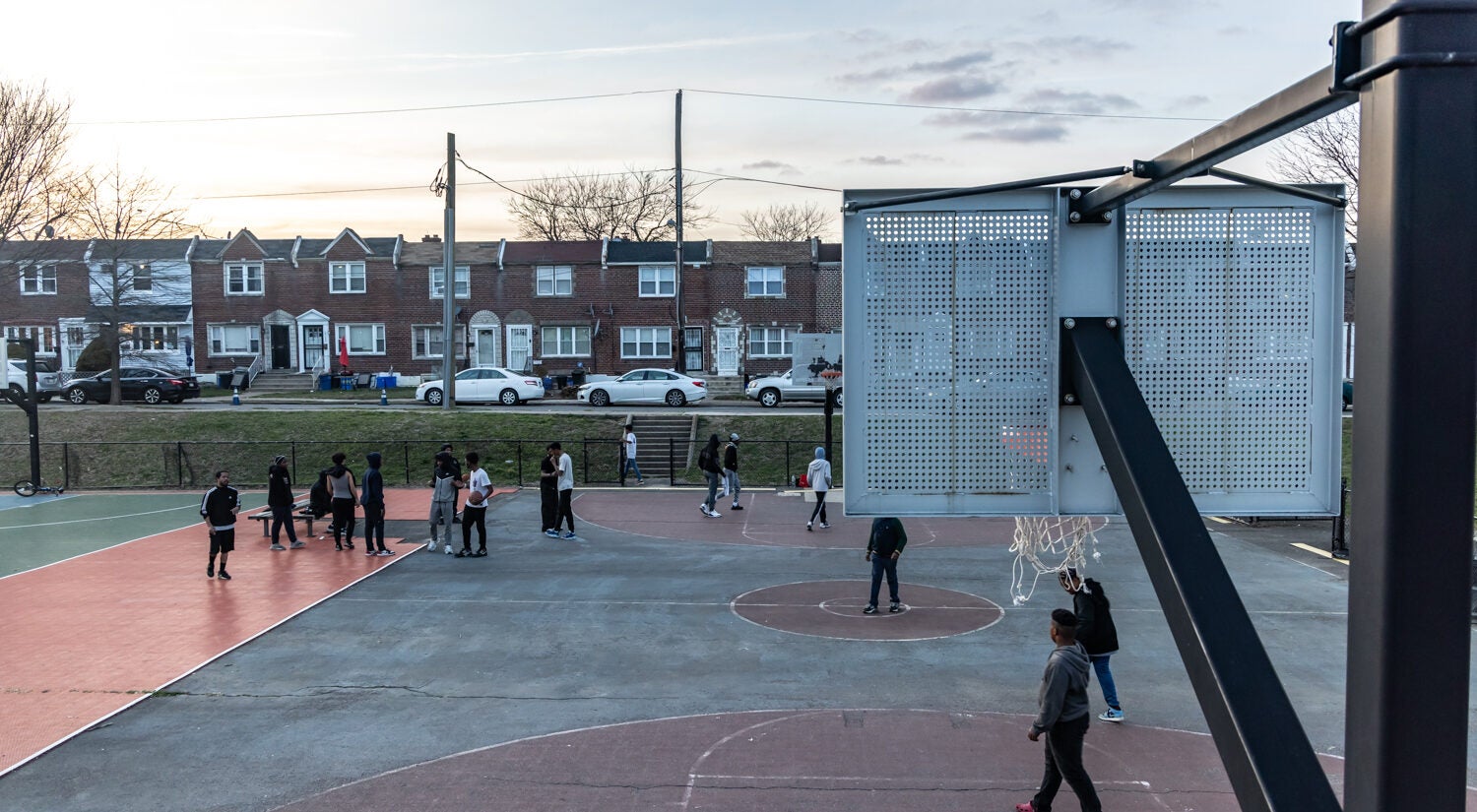
Years of understaffing
Budget documents show that actual staffing levels, as captured in mid-year snapshots, have not caught up to the increase in budgeted positions in Parks & Rec in recent years.
In November 2022, the most recent date for which actual staffing levels are available, the department was down more than a fifth of the recreational services, infrastructure and property management staff it received funding for that year.
“It’s becoming very frustrating,” said Brett Bessler, vice president and business agent with AFSCME District Council 47 Local 2186, the union representing rec center supervisors and grounds maintenance workers. “Staffing levels in Parks and Rec are absolutely abysmal.”
Bessler, a former recreation center leader at Smith and DiSilvestro playgrounds in South Philadelphia, describes a “cycle” of advocacy around Parks & Rec funding each budget season.
Over the past decade, with the exception of fiscal years 2020 and 2021, the department has successfully secured more funding and budgeted positions each year than the year before — but has failed to fill all of those positions, according to city budget documents. Part of the problem, Bessler said, is a shortage of human resources staffers.
“It’s very rare that you’re gonna hear a union officer advocating for more HR, but we do, we need more HR,” he said. “[And] if you’re having a hard time hiring rec leader trainees, pay them more.”
Safety is a big priority for Bessler’s members. The union advocated for a minimum staffing level of two staff per rec center, but the downside is that sometimes centers stay closed because only one staffer is available, he said.
“Up until recently you could be working in a rec center alone at 8, 9 o’clock at night. We felt that was really dangerous,” he said. “Now what we’re seeing is an inconsistent level of service.”
Young climate activists with the Sunrise Movement have rallied around the issue of staffing at libraries and rec centers. They held a demonstration at City Hall last fall — complete with a pop-up rec center — and blocked traffic this week, calling for enough funding to open libraries and rec centers seven days a week.
The activists are also pushing for renovations at all rec centers by 2030 that would prepare them for climate change, with rooftop solar, electrified appliances and flood resilience measures.
View this post on Instagram
Safety is top of mind for Cliff Logan, of the CLS Mustangs. After shooting incidents at McCreesh field — including one last August, where he said bullets flew past the faces of players and coaches — the team started doing active shooter drills. Logan said a consistent police presence at McCreesh would help deter gun violence and show that the city backs the community.
Bessler’s union not only wants existing positions filled, but also to have social workers, therapists and security guards added at many centers.
“We believe that these three positions would be able to transform our rec centers into community one-stop-shop kind of hubs,” he said.
With more personnel, the supervisors at parks, playgrounds and centers could also focus more on addressing other types of crime that can put a damper on visitors’ experiences, said Ruffian Tittman, executive director of the Friends of Wissahickon.
“Across the city we’re seeing an increase in break-ins. People come for a nice day at the park, and come back and find their windows smashed,” she said.
“There’s a number of ways that you increase safety overall, and not just for car break-ins, but all sorts of crime that may happen. One of those ways is increased staff presence in all areas. It doesn’t necessarily have to be police,” she said.
Another important task for the city and nonprofit groups is to address ATV riders that are “plaguing” the city’s neighborhoods and public spaces, including the otherwise blissfully calm Tacony Creek Park in Northeast Philly, said Justin DiBerardinis, the incoming executive director of Tookany/Tacony-Frankford Watershed Partnership and previously the city’s FDR Park director.
“A small number of users are so dominating the park with ATVs that it really does not make it a place that feels fully inviting, safe and welcoming for families to recreate and enjoy nature,” he said.
Dozens of capital projects in the pipeline
Leroy Fisher has seen what major investments can do to a park.
Fisher, the president of Hunting Park United and board member for the North Philadelphia Aztecs football and cheerleading team, remembers what Hunting Park looked like in the early 2000s.
“In an 87-acre park, you had one swing set,” he said. “All the ball fields were in deplorable, deplorable condition. With football, we utilized the field but we couldn’t play our games there. What we had to do is travel a mile away to play our games.”
Roughly $4.5 million in renovations between 2009 and 2018 brought a new multipurpose field, hundreds of new trees, two new playgrounds, a new baseball field, new tennis courts, new handball courts and upgraded lighting around the park’s perimeter road.
“You saw flocks and flocks of people start coming to the location,” Fisher said. “Participation in our programming [increased], participation with baseball, participation with tennis, handball — I could name programs for days that show without question the difference in how people feel safe being in the park.”
He wants to see Parker invest in new sports fields and rec centers throughout the city, and financially support youth sports afterschool programs.
“There are programs out here keeping kids off the street, keeping kids occupied, that have great numbers of kids,” he said.
Parker inherits Kenney’s signature Rebuild program, which is renovating parks, rec centers and libraries using funding from a tax on soda and sweetened beverages.
Litigation and the pandemic slowed Rebuild’s initial progress, and by the end of Kenney’s term in December, just 17 out of 72 planned projects were done. About three dozen more were under construction, in the process of public engagement or preparing for construction. Another 17 were pending or on hold.
One of the pending projects is Mander Playground in Strawberry Mansion. Neighborhood resident Judith Robinson, who pushed for a plaque at the playground commemorating its namesake — a man who died trying to save a drowning boy in the Schuylkill — remembers attending public visioning sessions at the playground before the pandemic. She’s disappointed that the Rebuild project at Mander and others nearby aren’t further along.
“Rebuild hasn’t been good for Black people west of Broad Street,” Robinson said.
City officials said last year they have enough funding to complete the Rebuild projects at all 72 libraries, rec centers and parks currently on the list. It remains to be seen whether Parker plans to add more of the 400-plus eligible sites to the list.
She was supportive of Rebuild as a councilmember, and after taking office moved the program into a newly created Capital Projects office. The previous executive director, Kira Strong, is no longer with Rebuild, according to an email announcing her departure that was shared with WHYY News. Parker’s office declined to comment.
One major capital project that Parker has expressed support for is the $250 million transformation of FDR Park in South Philly, which will include new playgrounds, a welcome center, nature trails and dozens of athletic fields and courts.
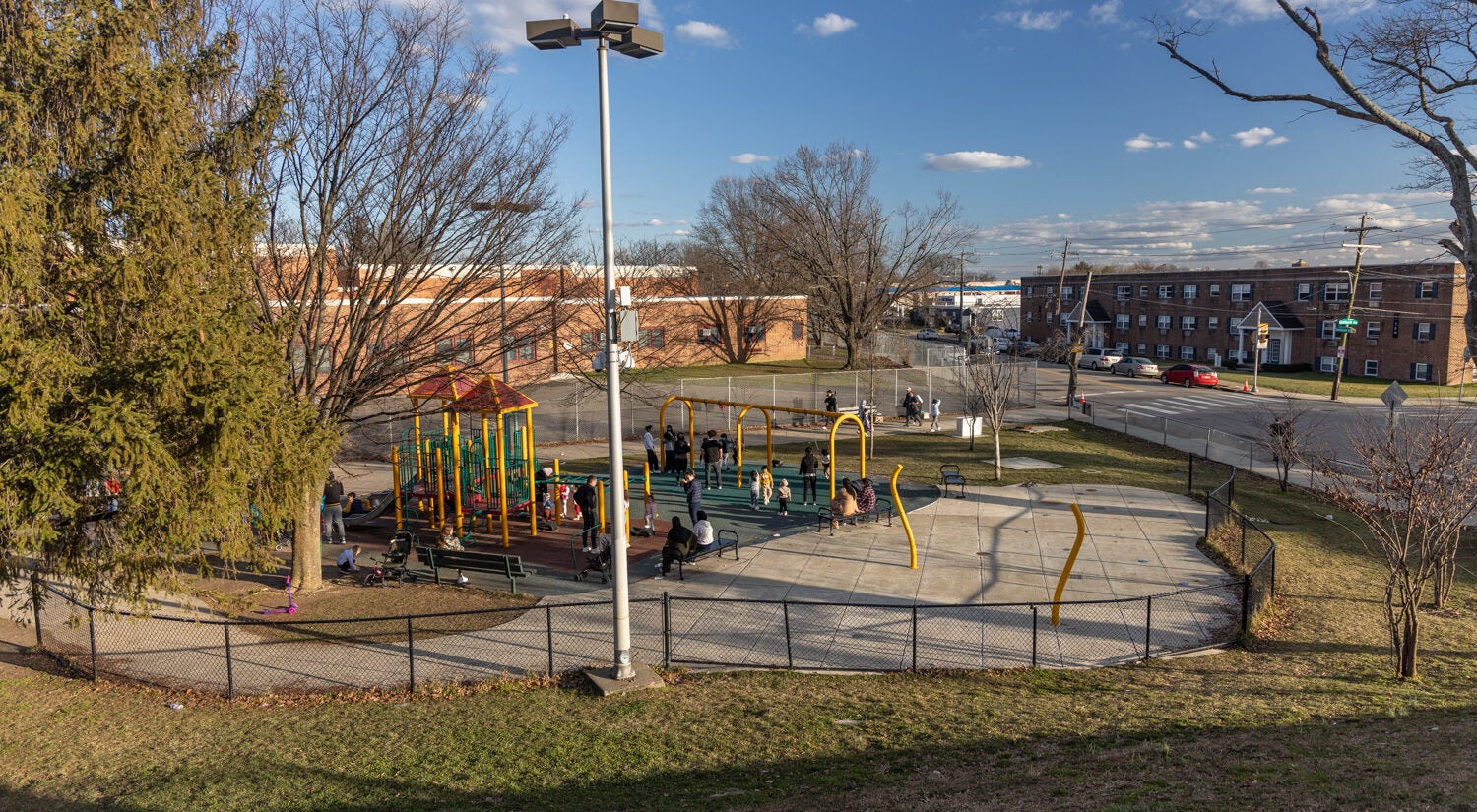
Parker joined youth sports leaders at a rally at FDR last month, where she said the project is “at the heart” of what her administration will do to keep young Philadelphians safe.
“Everything that I’ve seen in the plans being proposed has been thought through very carefully about diversity, equity and inclusion, and how we make the park better so it’s more welcoming for everybody, for people, no matter their race, class, socio-economic status or ZIP code,” Parker said. “We want to make sure that everyone feels welcome here.”
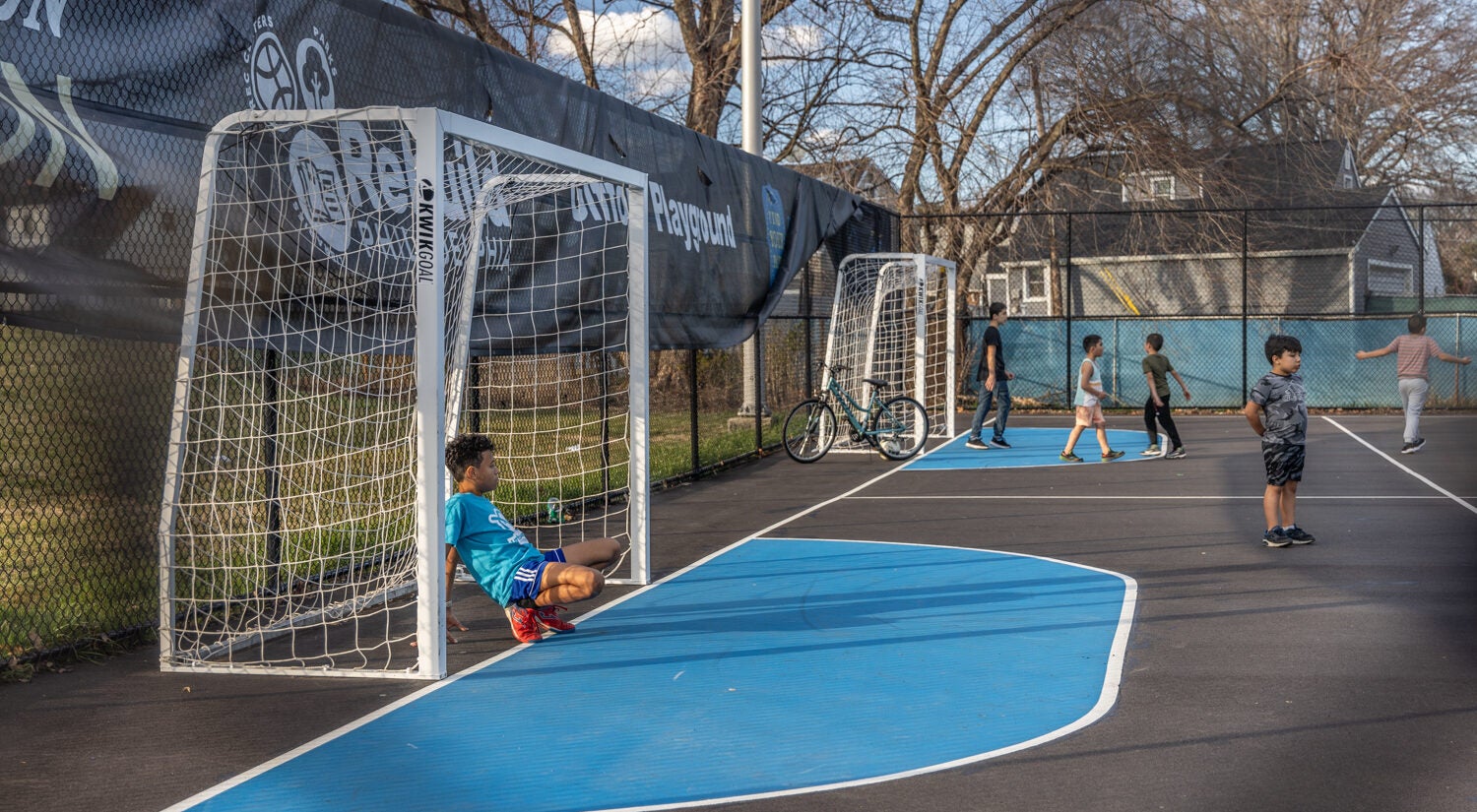
Accusations of greenwashing
But the FDR Park project has its detractors. Last month, two Registered Community Organizations voted against supporting a needed zoning exception. Residents criticized the Fairmount Park Conservancy’s plan to cut down 48 healthy heritage trees in order to build turf playing fields, baseball fields, basketball courts, tennis courts, two picnic areas, a playground and parking.
Save the Meadows, the main group opposing the renovation, argues elements of the project amount to privatization and greenwashing.
“Unfortunately, it really feels like the Parks Department views our natural resources as spaces for human recreation,” said Milder, an organizer with the group. “They value human recreation over the environmental benefits as well as these spaces being critical for all our flora and fauna.”
Ro Maurer, the Cobbs Creek Ambassadors volunteer, sees the development of natural spaces as a loss for human park users as well. She opposed the clear-cutting of hundreds of trees at the city-owned Cobbs Creek Golf Course for a renovation project there.
“The Philadelphia park system is a gem,” she said. “Philadelphia has such a wealth of beautiful nature that is very accessible and open to the public. Everybody deserves a green space that they can go to that’s free, that’s accessible, that feels safe, that’s clean. We really need to preserve that.”
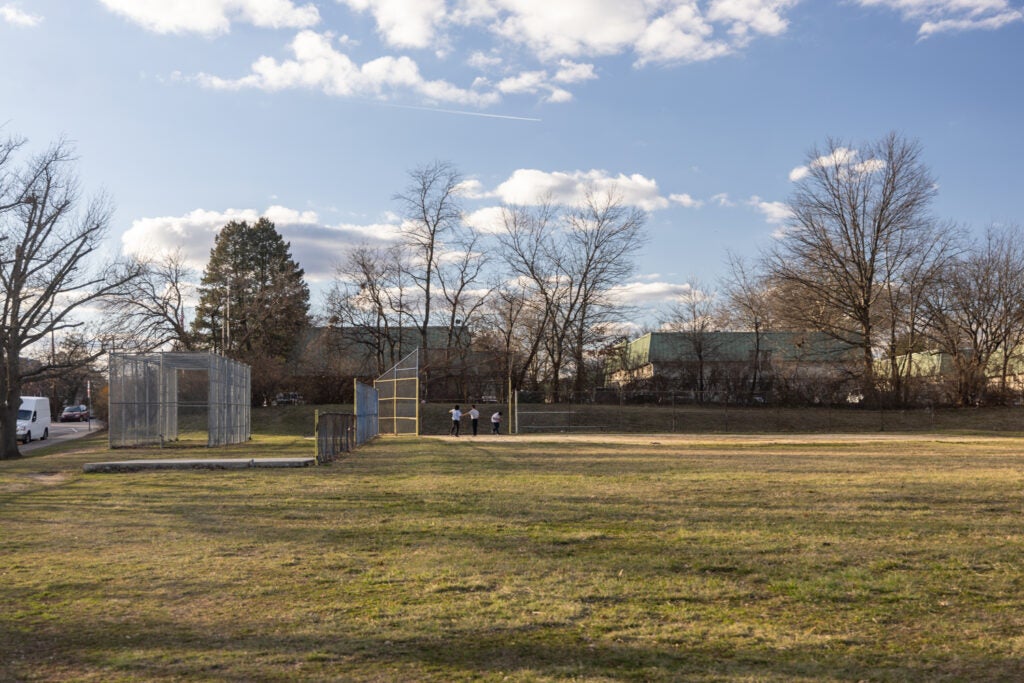
To Cliff Logan, of the CLS Mustangs, the proposed sports fields at FDR Park are a win for the city’s young athletes, and Parker’s support is a sign that she cares. He envisions the regional championships his teams travel to in Florida being held in South Philly one day.
Logan wants the city to fix up the Mustangs’ home field at McCreesh playground, too. He’d like to see it leveled, covered in turf, fenced in and encircled by a new track.
“That would increase the children and adults coming out,” he said. “That would definitely show that the city cares about us.”

Subscribe to PlanPhilly
WHYY is your source for fact-based, in-depth journalism and information. As a nonprofit organization, we rely on financial support from readers like you. Please give today.



